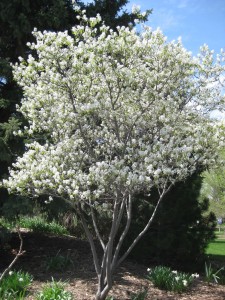 Fall means foliage and as I look around at the array of red, orange and yellow leaves, I wish for more of the same in my garden. The maple tree out front, which I estimate to be about twenty-five years old, generally makes a great show of fiery leaves. Climate conditions this year have diminished the fireworks, but they will still happen on a smaller scale.
Fall means foliage and as I look around at the array of red, orange and yellow leaves, I wish for more of the same in my garden. The maple tree out front, which I estimate to be about twenty-five years old, generally makes a great show of fiery leaves. Climate conditions this year have diminished the fireworks, but they will still happen on a smaller scale.
I have room for exactly one more small tree and I would like it to be a variety that shines in autumn. Since my yard is not large, it would be nice if the designated tree performed in other seasons as well. Flowers are always welcome in the spring, as are acceptable summer leaves. The birds, especially the beautiful, raucous and omnivorous blue jays, will thank me if I plant something that produces berries or fruit. In the cold months, when my eyes appreciate anything with even a small amount of horticultural interest, attractive bark would be a definite plus.
Fortunately a hero-tree has ridden in on a white-flowered horse. My hero tree is known by many names, including shadblow, serviceberry, shadbush, sarvis, snowy mespilus and juneberry, but its formal Latin name is Amalanchier.
The shadblow is a member of the enormous rose family and the resemblance is most notable in the unripened berries, which look a little like rose hips. The Amalanchier genus is home to between twenty and thirty species. Among them is Amalanchier canadensis, the candidate for my open garden position.
Unlike many common ornamental trees and shrubs, shadblow is a North American native and was here to greet the European colonists. The “shadblow” name most likely stems from the fact that the trees flower concurrently in spring with shad running in rivers and streams. Shad was a plentiful food source for Native Americans and colonists, so the flowering of the shadblow was a harbinger of full stomachs. Prominent early American gardeners like George Washington and Thomas Jefferson planted them on their estates. Contemplating life and nature on Walden Pond, Henry David Thoreau took note of the shadblow. The trees also adorn the historic Mount Auburn Cemetery outside of Boston.
Amalanchier can be grown as a multi-stemmed shrub, but I have seen it most often in tree or standard form. Reaching a height of twenty to thirty feet, it can also be kept smaller, if necessary, by a little judicious pruning.
It is easy to catalog shadblow’s virtues, starting with its spring flowers. They are small and white, covering the tree with lightly fragrant clusters in early spring. Like redbud trees, shadblow lets its flowers ring in the new season. Bees, hungry after winter, appreciate this. The small, ovoid green leaves appear later. When the flowers fade away, the trees begin the process of forming berries, which give the genus one of its common names, serviceberry.
These fruits form as small green globes, ripening to red and ultimately to purple-black in June. The berries are not large, only up to one-third inch in diameter, but they are edible and slightly sweet. If you can outwit the hungry birds, you can pick the serviceberries and make them into tasty pies, tarts, jellies and jams. True guru Michael Dirr, who likes his victuals, says, “I have had serviceberry pie and it ranks in the first order of desserts.”
If you don’t feel up to a fight, and you let the birds take the edible spoils, you will still have the leaves, which are medium green in summer, and flaming orange-red in fall. The beauty of the leaves makes up for the fact that you will have to clear them away when they finally descend to the ground.
In winter, when holiday decorations, evergreens and the skeletons of deciduous trees are all we have for aesthetic sustenance, shadblow offers pretty grayish bark with what Dr. Dirr calls “longitudinal fissures” that may harbore a touch of red. It is truly a four-season performer, pleasing humans and providing food and habitat to birds, butterflies and small mammals.
Is there any downside to such a wonderful tree? It thrives in sun to light shade, which is what it will have in the corner of my yard. Shadblow likes consistent moisture, which means that it will need supplemental water during dry periods. Though tolerant of clay soils, amending the planting hole with a compost/soil mix and mulching the ground around the newly planted tree with a doughnut-shaped covering of organic matter, will help keep the roots happy.
If I order and shadblow now, it will arrive just in time for fall planting. With any luck I can celebrate the arrival of the first few flowers next spring. Local nurseries may carry shadblow for fall planting, but if you have to look farther afield, try ForestFarm at Pacifica, 14643 Watergap Rd, Williams, OR 97544; (541) 846-7269; www.forestfarm.com. Free print catalog.
